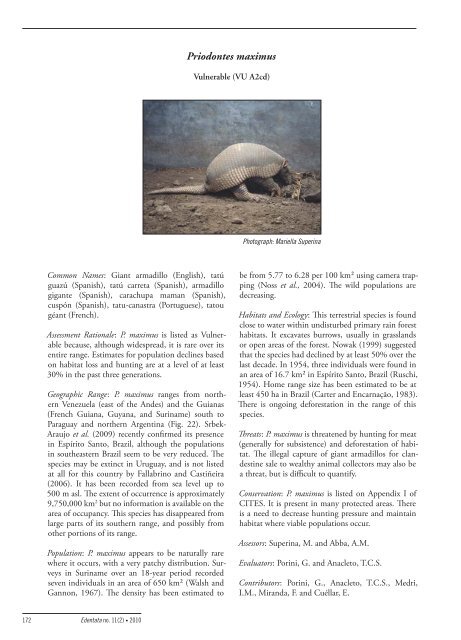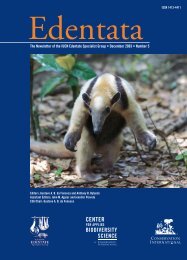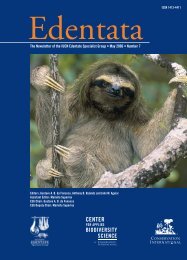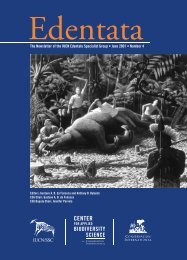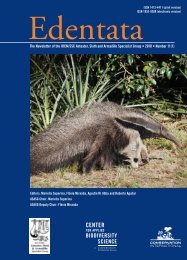Edentata 11(2), 2010 - Anteater, Sloth & Armadillo Specialist Group
Edentata 11(2), 2010 - Anteater, Sloth & Armadillo Specialist Group
Edentata 11(2), 2010 - Anteater, Sloth & Armadillo Specialist Group
- No tags were found...
You also want an ePaper? Increase the reach of your titles
YUMPU automatically turns print PDFs into web optimized ePapers that Google loves.
Priodontes maximusVulnerable (VU A2cd)Photograph: Mariella SuperinaCommon Names: Giant armadillo (English), tatúguazú (Spanish), tatú carreta (Spanish), armadillogigante (Spanish), carachupa maman (Spanish),cuspón (Spanish), tatu-canastra (Portuguese), tatougéant (French).Assessment Rationale: P. maximus is listed as Vulnerablebecause, although widespread, it is rare over itsentire range. Estimates for population declines basedon habitat loss and hunting are at a level of at least30% in the past three generations.Geographic Range: P. maximus ranges from northernVenezuela (east of the Andes) and the Guianas(French Guiana, Guyana, and Suriname) south toParaguay and northern Argentina (Fig. 22). Srbek-Araujo et al. (2009) recently confirmed its presencein Espírito Santo, Brazil, although the populationsin southeastern Brazil seem to be very reduced. Thespecies may be extinct in Uruguay, and is not listedat all for this country by Fallabrino and Castiñeira(2006). It has been recorded from sea level up to500 m asl. The extent of occurrence is approximately9,750,000 km 2 but no information is available on thearea of occupancy. This species has disappeared fromlarge parts of its southern range, and possibly fromother portions of its range.Population: P. maximus appears to be naturally rarewhere it occurs, with a very patchy distribution. Surveysin Suriname over an 18-year period recordedseven individuals in an area of 650 km² (Walsh andGannon, 1967). The density has been estimated tobe from 5.77 to 6.28 per 100 km² using camera trapping(Noss et al., 2004). The wild populations aredecreasing.Habitats and Ecology: This terrestrial species is foundclose to water within undisturbed primary rain foresthabitats. It excavates burrows, usually in grasslandsor open areas of the forest. Nowak (1999) suggestedthat the species had declined by at least 50% over thelast decade. In 1954, three individuals were found inan area of 16.7 km² in Espírito Santo, Brazil (Ruschi,1954). Home range size has been estimated to be atleast 450 ha in Brazil (Carter and Encarnação, 1983).There is ongoing deforestation in the range of thisspecies.Threats: P. maximus is threatened by hunting for meat(generally for subsistence) and deforestation of habitat.The illegal capture of giant armadillos for clandestinesale to wealthy animal collectors may also bea threat, but is difficult to quantify.Conservation: P. maximus is listed on Appendix I ofCITES. It is present in many protected areas. Thereis a need to decrease hunting pressure and maintainhabitat where viable populations occur.Assessors: Superina, M. and Abba, A.M.Evaluators: Porini, G. and Anacleto, T.C.S.Contributors: Porini, G., Anacleto, T.C.S., Medri,I.M., Miranda, F. and Cuéllar, E.172<strong>Edentata</strong> no. <strong>11</strong>(2) • <strong>2010</strong>


